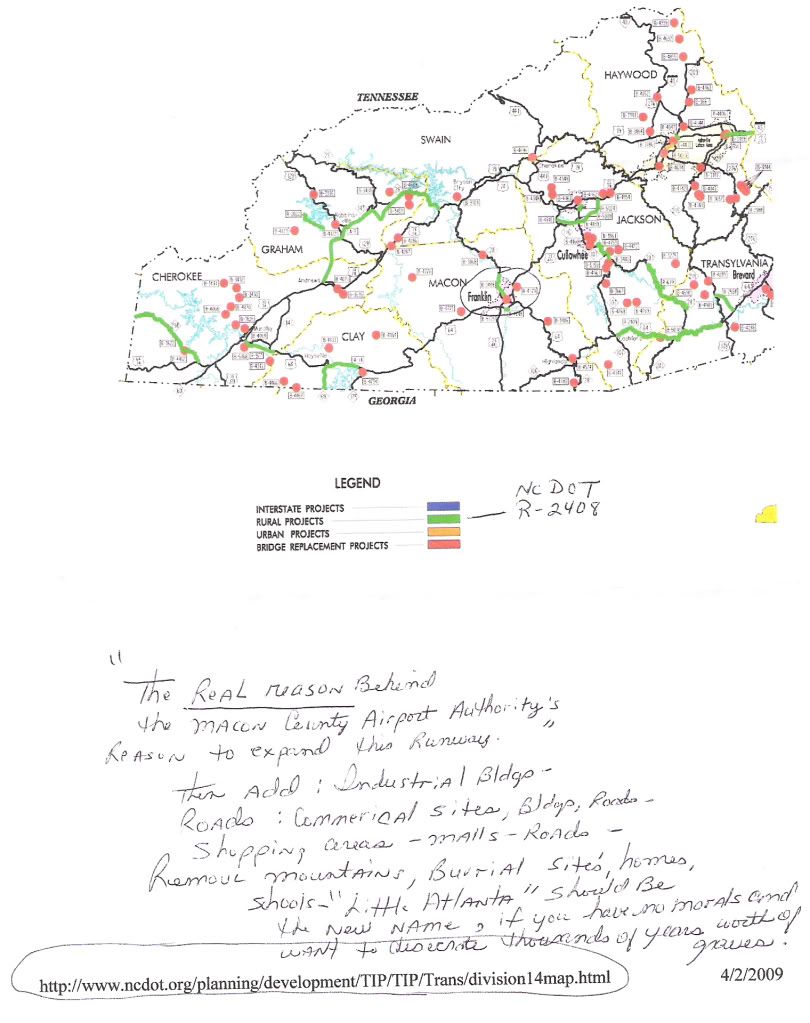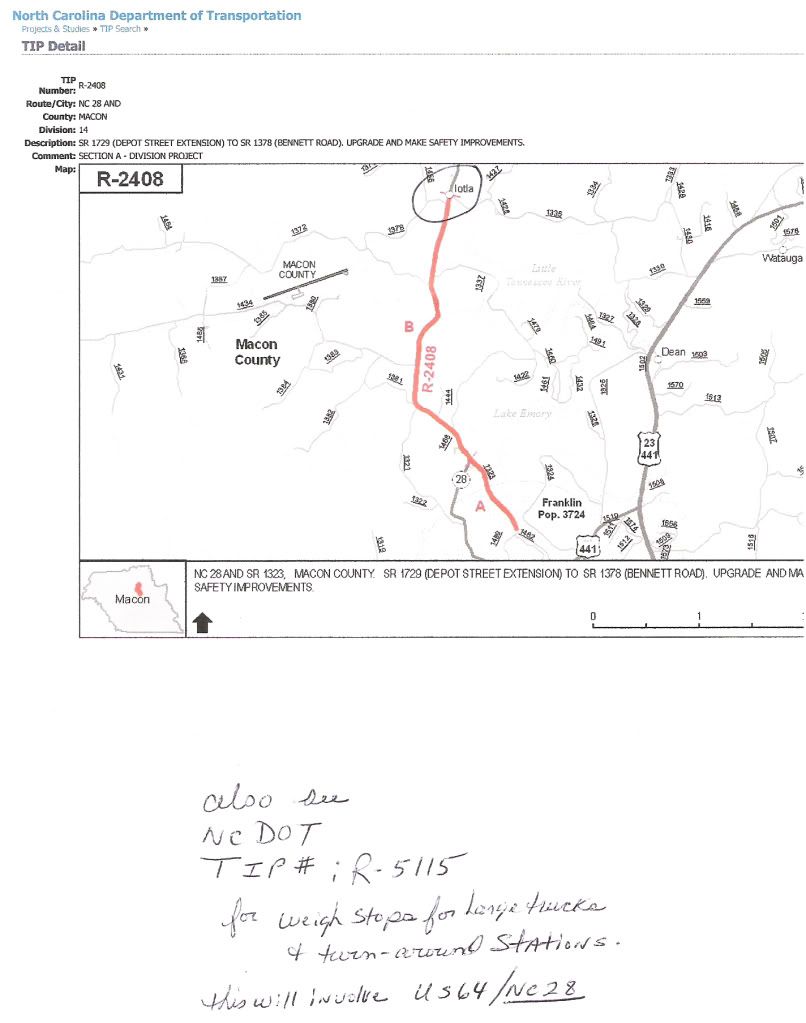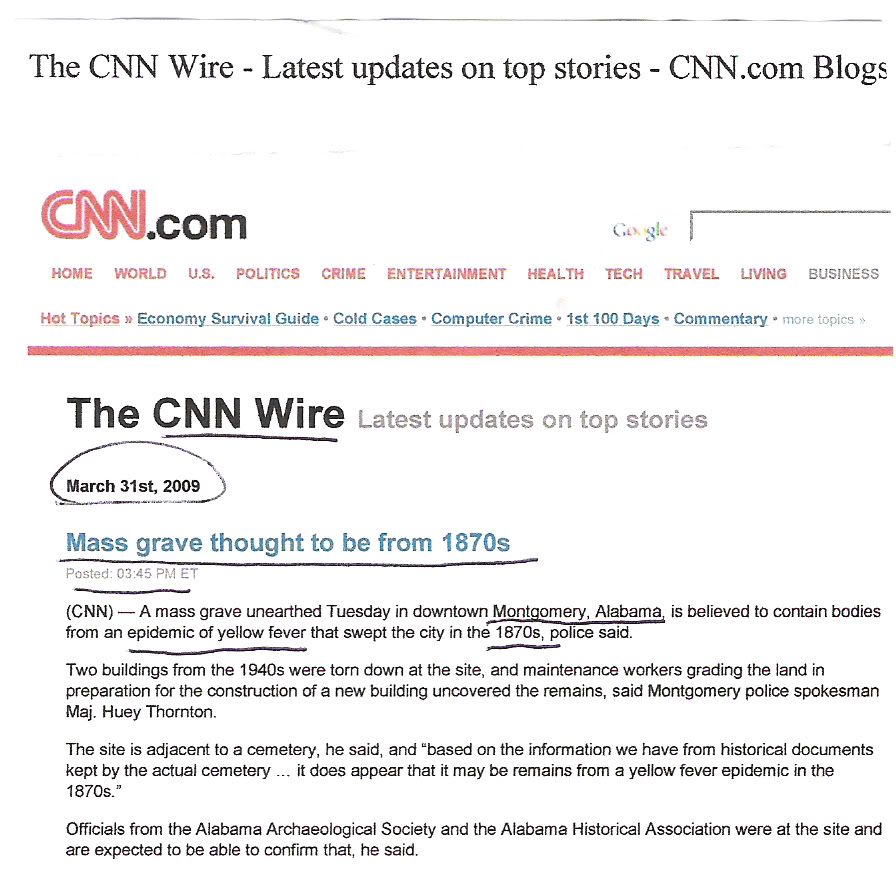Where swine & Bird flue Came from
Floow the link please>
http://blogs.myspace.com/index.cfm?fuseaction=blog.view&friendId=98128197&blogId=486440475
Thursday, April 30, 2009
Saturday, April 4, 2009
The Real Reason Behind The Destruction of The Cherokee Iotla Site From STSSA Founder
Ga. Residents Illegal Dogfighting Ring/ [GVAW] HEADS UP! DOGS MISSING IN MIDWAY AREA
Ga. Residents Illegal Dogfighting Ring/ [GVAW] HEADS UP! DOGS MISSING IN MIDWAY AREA
[GVAW] HEADS UP! DOGS MISSING IN MIDWAY AREA
PLEASE BE SURE AND
CROSS-POST THIS WIDELY.
Hannah deSoto Tostensen
Darien, Georgia
"You must be the change you wish to
see." Ghandi
Woman
says dogs in Midway are disappearing
WTOC - Savannah,GA,USA
Not that the dog ran away,
but that someone stole Wednesday and is using her in a dog
fighting ring. As soon as Wednesday disappeared, Midkiff posted the
...
BB KNOWLES
WWW.NCVAW.ORG
DOG FIGHTING: "SOME CALL IT A SPORT; N.C. CALLS IT A FELONY"
~~~~~~~~~~~~~~~~~~~~
DOGFIGHTING HOT LINE
-- The Dogfighting Hot Line (1-877-847-4787) is sponsored by the HSUS.
-- You can receive an award of up to $5,000 for information leading to the
arrest and conviction of a dogfighter.
-- All information is kept confidential; no one will know you've called.
-- The line is answered 24/7.
-- You can leave a message, talk to an investigator, or get their e-mail
address and leave your own.
-- If a dogfight is in progress, immediately call the police, 9-1-1. Then
call the hot line.
"Thus it is said that one who knows the enemy and knows himself will not be
endangered in a hundred engagements."
Sun Tzu, The Art of War.
[GVAW] HEADS UP! DOGS MISSING IN MIDWAY AREA
PLEASE BE SURE AND
CROSS-POST THIS WIDELY.
Hannah deSoto Tostensen
Darien, Georgia
"You must be the change you wish to
see." Ghandi
Woman
says dogs in Midway are disappearing
WTOC - Savannah,GA,USA
Not that the dog ran away,
but that someone stole Wednesday and is using her in a dog
fighting ring. As soon as Wednesday disappeared, Midkiff posted the
...
BB KNOWLES
WWW.NCVAW.ORG
DOG FIGHTING: "SOME CALL IT A SPORT; N.C. CALLS IT A FELONY"
~~~~~~~~~~~~~~~~~~~~
DOGFIGHTING HOT LINE
-- The Dogfighting Hot Line (1-877-847-4787) is sponsored by the HSUS.
-- You can receive an award of up to $5,000 for information leading to the
arrest and conviction of a dogfighter.
-- All information is kept confidential; no one will know you've called.
-- The line is answered 24/7.
-- You can leave a message, talk to an investigator, or get their e-mail
address and leave your own.
-- If a dogfight is in progress, immediately call the police, 9-1-1. Then
call the hot line.
"Thus it is said that one who knows the enemy and knows himself will not be
endangered in a hundred engagements."
Sun Tzu, The Art of War.
ACTION ALERT: NARRAGANSETT SCHOOL NEEDS ASSISTANCE TO STAY OPEN THIS SPRING
ACTION ALERT: NARRAGANSETT SCHOOL NEEDS ASSISTANCE TO STAY OPEN THIS SPRING
The Nuweetooun School in Exeter, Rhode Island, is New England's only
independent,Native-American-..run school currently serving Native
children. The school uses a holisticcurriculum, based on Native
culture and history, to nurture and engage students K-8. Because
most students are unable to make tuition, Nuweetooun is supported
heavily by private donations from individuals, local tribes, and
foundations.
This spring, already stretched to the limit, school staff have learned
that they must replace some old lead pipes in their building, or risk
closing. The cost of the project is $8K, and the volunteer board of
directors has already managed to raise $6K. A final push now of small
donations from interested supporters could help Nuweetooun stay open
and continue its mission!
To learn more about the school, visit
http://www.tomaquagmuseum.com/..index.cfm?ac=school
or contact Loren Spears at Lorenspears@tomaquagmuseum.com... To make a
donation, send a check (payable to TIMM, Inc.) to Nuweetooun School,
390 Summit Road, Exeter, RI 02822. Contributions are tax-deductible
under IRS code 501(c)3.
Posted by Siobhan Senier
Board of Directors, Tomaquag Indian Memorial Museum, Inc.
Associate Professor, English
University of New Hampshire
ssenier@unh.edu
The Nuweetooun School in Exeter, Rhode Island, is New England's only
independent,Native-American-..run school currently serving Native
children. The school uses a holisticcurriculum, based on Native
culture and history, to nurture and engage students K-8. Because
most students are unable to make tuition, Nuweetooun is supported
heavily by private donations from individuals, local tribes, and
foundations.
This spring, already stretched to the limit, school staff have learned
that they must replace some old lead pipes in their building, or risk
closing. The cost of the project is $8K, and the volunteer board of
directors has already managed to raise $6K. A final push now of small
donations from interested supporters could help Nuweetooun stay open
and continue its mission!
To learn more about the school, visit
http://www.tomaquagmuseum.com/..index.cfm?ac=school
or contact Loren Spears at Lorenspears@tomaquagmuseum.com... To make a
donation, send a check (payable to TIMM, Inc.) to Nuweetooun School,
390 Summit Road, Exeter, RI 02822. Contributions are tax-deductible
under IRS code 501(c)3.
Posted by Siobhan Senier
Board of Directors, Tomaquag Indian Memorial Museum, Inc.
Associate Professor, English
University of New Hampshire
ssenier@unh.edu
NAGPRA: Writing and Managing a Successful Grant
NAGPRA: Writing and Managing a Successful Grant
Seattle, Washington
May 20-21, 2009
Purpose of the Seminar:
The
National NAGPRA Program offers grants to assist museums, Indian tribes,
Native Hawaiian organizations and Alaska Native villages and
corporations with the NAGPRA process. Review practical tools and case
studies of successful grant applications and projects. Learn how to
assess the needs of a NAGPRA program, identify fundable projects, and
write and manage a successful grant.
The
seminar instructors are Sangita Chari, Grants Coordinator, National
NAGPRA Program, and Jan I. Bernstein, Director, Bernstein &
Associates.
Who May Attend:
The
seminar is open to participants from Native American tribes, Alaska
Native villages and corporations, Native Hawaiian organizations,
museums, and individuals interested in NAGPRA grants.
How to Register:
Download and complete the registration form available at www.npi.org.
Cost and Funding Sources:
The cost of registration for the seminar is $375 before April 8, $425 regular rate, $175 student.
· If
you are a representative of a Native American tribe, Alaska Native
village or corporation, or Native Hawaiian organization, the National
NAGPRA Program has scholarships available for registration. The
scholarship application form is available at www.npi.org.
· NEW GRANTS for accommodations, travel and per diem!!!
If you are affiliated with a tribe, Native Hawaiian organization, or Alaska Native village or corporation and
you are committed to attending the entire seminar, the National Museum
of the American Indian is offering a $1,000 grant per applicant for the
first 15 people who qualify. The grant is payable upon completion of
the seminar to offset the costs for accommodations, travel and per diem
to attend the workshop. No application necessary. Please contact the
National Preservation Institute at info@npi.org or 703.765.0100.
· Additional funding opportunities are available at www.npi.org.
For more information contact:
National Preservation Institute
P.O Box 1702
Alexandria, VA 22313-1702
703.765.0100
info@npi.org
This
training is offered through a partnership of the National NAGPRA
Program, the National Preservation Institute and the National Museum of
the American Indian.
From: Lesa Koscielski, National NAGPRA Contractor
-----
Teresa Anahuy
http://groups.yahoo.com/group/..FirstPeoplesNews
Seattle, Washington
May 20-21, 2009
Purpose of the Seminar:
The
National NAGPRA Program offers grants to assist museums, Indian tribes,
Native Hawaiian organizations and Alaska Native villages and
corporations with the NAGPRA process. Review practical tools and case
studies of successful grant applications and projects. Learn how to
assess the needs of a NAGPRA program, identify fundable projects, and
write and manage a successful grant.
The
seminar instructors are Sangita Chari, Grants Coordinator, National
NAGPRA Program, and Jan I. Bernstein, Director, Bernstein &
Associates.
Who May Attend:
The
seminar is open to participants from Native American tribes, Alaska
Native villages and corporations, Native Hawaiian organizations,
museums, and individuals interested in NAGPRA grants.
How to Register:
Download and complete the registration form available at www.npi.org.
Cost and Funding Sources:
The cost of registration for the seminar is $375 before April 8, $425 regular rate, $175 student.
· If
you are a representative of a Native American tribe, Alaska Native
village or corporation, or Native Hawaiian organization, the National
NAGPRA Program has scholarships available for registration. The
scholarship application form is available at www.npi.org.
· NEW GRANTS for accommodations, travel and per diem!!!
If you are affiliated with a tribe, Native Hawaiian organization, or Alaska Native village or corporation and
you are committed to attending the entire seminar, the National Museum
of the American Indian is offering a $1,000 grant per applicant for the
first 15 people who qualify. The grant is payable upon completion of
the seminar to offset the costs for accommodations, travel and per diem
to attend the workshop. No application necessary. Please contact the
National Preservation Institute at info@npi.org or 703.765.0100.
· Additional funding opportunities are available at www.npi.org.
For more information contact:
National Preservation Institute
P.O Box 1702
Alexandria, VA 22313-1702
703.765.0100
info@npi.org
This
training is offered through a partnership of the National NAGPRA
Program, the National Preservation Institute and the National Museum of
the American Indian.
From: Lesa Koscielski, National NAGPRA Contractor
-----
Teresa Anahuy
http://groups.yahoo.com/group/..FirstPeoplesNews
Carol Jean Vigil, first Indian judge,dies at 61
Carol Jean Vigil, first Indian judge,dies at 61.
Carol Jean Vigil, first Indian judge,dies at 61
Posted by: "Shirl4116@aol.com"
Shirl4116@aol.com
shirl4116
Tue Mar 31, 2009 5:27 am (PDT)
Carol Jean Vigil, first Indian judge, dies at 61
Monday, March 30, 2009
Carol Jean Vigil, a Tesuque Pueblo woman who broke race and gender barriers,
died last Friday. She was 61.
Vigil was the first Indian be elected as a state judge in New Mexico and the
first Indian in the U.S. to be elected as a judge of a general jurisdiction
court. She was the first Pueblo woman to pass the New Mexico bar exam.
"She was very serious about her work, really concerned about getting it
right," attorney C. Bryant Rogers told The Santa Fe New Mexican.
Vigil was elected to her state court position in 1998. She retired in 2005.
Get the Story:
_Dedicated Native American judge broke race barrier _
(http://www.indianz.com/my...asp?url=http://www...santafenewmexican.com/Local%..20News/Carol-Jean-Vigil--19
46-2009-Dedicated-Native-
..American-judge-bro) (The Santa Fe New Mexican 3/29)
Carol Jean Vigil, first Indian judge,dies at 61
Posted by: "Shirl4116@aol.com"
Shirl4116@aol.com
shirl4116
Tue Mar 31, 2009 5:27 am (PDT)
Carol Jean Vigil, first Indian judge, dies at 61
Monday, March 30, 2009
Carol Jean Vigil, a Tesuque Pueblo woman who broke race and gender barriers,
died last Friday. She was 61.
Vigil was the first Indian be elected as a state judge in New Mexico and the
first Indian in the U.S. to be elected as a judge of a general jurisdiction
court. She was the first Pueblo woman to pass the New Mexico bar exam.
"She was very serious about her work, really concerned about getting it
right," attorney C. Bryant Rogers told The Santa Fe New Mexican.
Vigil was elected to her state court position in 1998. She retired in 2005.
Get the Story:
_Dedicated Native American judge broke race barrier _
(http://www.indianz.com/my...asp?url=http://www...santafenewmexican.com/Local%..20News/Carol-Jean-Vigil--19
46-2009-Dedicated-Native-
..American-judge-bro) (The Santa Fe New Mexican 3/29)
We Shall Remain: Teaching Native American Culture Within American History
We Shall Remain: Teaching Native American Culture Within American History
By Eric Langhorst - April 01, 2009
How do you teach Native American
history and culture in the context of an American history class? Is the
Native American content taught in separate components or woven within
the framework of the remainder of the curriculum? As an 8th grade
history teacher, I know that unfortunately in many textbooks Native
American culture is compartmentalized and taught from an outside
perspective. "We Shall Remain," the new documentary series from
American Experience and PBS airing in April and May
(check your local listings), is an invaluable resource for teachers who
wish to teach Native American culture within the curriculum of United
States history courses. The series includes five films, each offering a
unique approach, depicting the role of Native Americans within the
context of American history. The five episodes include: "After the
Mayflower," "Tecumseh's Vision," "Trail of Tears," "Geronimo" and
"Wounded Knee."
I recently asked my 8th grade American
history students what immediately came to mind when I said "Native
American." Several mentioned the help Native Americans provided the
Corps of Discovery on their expedition to the West, a topic we recently
discussed in class. Many of the responses, however, characterized
Native Americans in militaristic terms - focusing on warfare, attacks
and battles. Additional common responses included "Thanksgiving,"
"teepees," and "hunting bison." These responses left me disappointed,
in part with the limits of my instruction. The history of Native
Americans in North America is much richer and more fascinating than
just these highly stereotypical glances.
The sheer volume of content - 7.5 hours
- that comprises "We Shall Remain" can invoke two emotions in
educators: excitement and intimidation. The content is incredible, as
is to be expected from an American Experience production, but it can
seem overwhelming to a classroom teacher with a curriculum already
stretched thin. As I watched the series, I viewed the content from two
perspectives: 1) personal content enrichment and 2) inclusion in the
curriculum. I discovered that there are ample opportunities for both.
For example, I discovered that Episode 2
- "Tecumseh's Vision" - matches the curriculum for my class. I
currently teach about Tecumseh in my junior high American history
class, but our focus has traditionally been limited to general
references to his historical importance in uniting several Native
American tribes in defiance of the United States government. As I
watched the 90-minute episode, I was captivated by the story of
Tecumseh and his relationship with his brother. The episode shows
Tecumseh as so much more than just a Native American leader who
rebelled against the invading American settlers. Tecumseh is depicted
as a natural leader with the ability to assemble a diverse group of
cultures into a unified cause in an attempt to save their way of life.
Leaders from both the British and United States militaries respected
his leadership qualities. As a teacher, I can now describe with much
more depth the story of Techumseh's life. This is an example of how
teachers can use this series for personal content enrichment.
Showing
the entire episode in class may not be possible for some teachers due
to time constraints, but I do plan on using a segment from the episode
in class with my students as well. The five-minute clip I will show is
the dramatic meeting between eventual president William Henry Harrison
and Tecumseh. With a proper lead in, the students will appreciate the
tension and importance of this moment.
Additionally, I found
that episode 1 - "After the Mayflower" - includes several segments
describing the economic interdependence between the Wampanoag and the
Pilgrims, which I can incorporate into my class. Many history teachers
struggle with techniques to teach economic concepts in the United
States history curriculum, so this film is a valuable new resource.
Episode
5 - "Wounded Knee" - describes the 1973 standoff between supporters of
the American Indian Movement and United States Marshalls, which lasted
71 days. I think an excellent activity for a high school civics class
would be a comparison of the Wounded Knee incident and other struggles
for civil rights in American history.
"We Shall Remain" has an excellent companion website
that offers a variety of resources, many of which can help teachers
expand the discussion of Native American culture in your history
classes. Many students have the misconception that all Native American
culture has faded away. The website includes two resources to help your
students make a connection with what it means to be a Native American
in the 21st century. ReelNative
is a collection of short - 5 to 10 minute - video documentaries
depicting contemporary issues as seen through the eyes of Native
Americans. The videos are available for viewing online and are a great
way to generate discussion in class. Native Now,
another section on the website, describes major issues affecting Native
culture today, including language, sovereignty and enterprise. This
section of the site includes video interviews, articles, and links to
additional resources.
The website will also include a comprehensive Teacher's Guide
with descriptions of individual episodes and chapters; comprehension,
discussion and analysis questions related to each episode; activities
to incorporate the films in class; and links to additional information.
Watching
"We Shall Remain" has helped me reconsider the manner in which I teach
Native American history in my own classroom. I found that I could do
more to integrate Native American culture into additional units of
study.
How do you teach Native American history
and culture in your history classes? I encourage you to share your
experiences. Please leave a comment on this blog and help us to create
a month-long discussion of the topic featuring teachers with diverse
perspectives.
Many more links at: www.pbs.org/teachers/..mediainfusion/2009/04/we_..shall_remain_teaching_nativ...html
-----
Teresa Anahuy
http://groups.yahoo.com/group/..FirstPeoplesNews
@@@@@@@@@@@@@@@@@@@@@@@@@@@@@@@@@
THOUGH THE EYES OF NATIVES !! WE SHALL REMAIN
http://www.pbs.org/..weshallremain
PBS airdates: Monday, April 13 May 11,2009 (check local listings) PBS
American Experience presents WE SHALL REMAIN, a groundbreaking
mini-series and provocative multi-media project that establishes Native
history as an essential part of American history. Five 90- minute
documentaries spanning three hundred years tell the story of pivotal
moments in U.S. history from the Native American perspective. WE SHALL
REMAIN premieres April 13, 2009 on PBS. A companion public radio
documentary series, focusing on contemporary Native issues, will be
distributed to public radio and Native broadcasters to coincide with
the television program. For more, visit http://www.pbs.org/..weshallremain Buy the DVD: http://www.shoppbs.org/entry...point?en...
Category:
Education
Tags:
native american
pbs
We shall remain
indian
american experience
history
united states
CHECK OUT U TUBE !!!
http://www.youtube.com/watch?..v=jxf5w6e5tvQ
<0><0><0><0><0><0><0><0>
Being Indian its not,
Just the "Blood"....Its "Living the way"......
{Karenshadowdancer}
http://www.picturetrail.com/..karenshadowdancer
By Eric Langhorst - April 01, 2009
How do you teach Native American
history and culture in the context of an American history class? Is the
Native American content taught in separate components or woven within
the framework of the remainder of the curriculum? As an 8th grade
history teacher, I know that unfortunately in many textbooks Native
American culture is compartmentalized and taught from an outside
perspective. "We Shall Remain," the new documentary series from
American Experience and PBS airing in April and May
(check your local listings), is an invaluable resource for teachers who
wish to teach Native American culture within the curriculum of United
States history courses. The series includes five films, each offering a
unique approach, depicting the role of Native Americans within the
context of American history. The five episodes include: "After the
Mayflower," "Tecumseh's Vision," "Trail of Tears," "Geronimo" and
"Wounded Knee."
I recently asked my 8th grade American
history students what immediately came to mind when I said "Native
American." Several mentioned the help Native Americans provided the
Corps of Discovery on their expedition to the West, a topic we recently
discussed in class. Many of the responses, however, characterized
Native Americans in militaristic terms - focusing on warfare, attacks
and battles. Additional common responses included "Thanksgiving,"
"teepees," and "hunting bison." These responses left me disappointed,
in part with the limits of my instruction. The history of Native
Americans in North America is much richer and more fascinating than
just these highly stereotypical glances.
The sheer volume of content - 7.5 hours
- that comprises "We Shall Remain" can invoke two emotions in
educators: excitement and intimidation. The content is incredible, as
is to be expected from an American Experience production, but it can
seem overwhelming to a classroom teacher with a curriculum already
stretched thin. As I watched the series, I viewed the content from two
perspectives: 1) personal content enrichment and 2) inclusion in the
curriculum. I discovered that there are ample opportunities for both.
For example, I discovered that Episode 2
- "Tecumseh's Vision" - matches the curriculum for my class. I
currently teach about Tecumseh in my junior high American history
class, but our focus has traditionally been limited to general
references to his historical importance in uniting several Native
American tribes in defiance of the United States government. As I
watched the 90-minute episode, I was captivated by the story of
Tecumseh and his relationship with his brother. The episode shows
Tecumseh as so much more than just a Native American leader who
rebelled against the invading American settlers. Tecumseh is depicted
as a natural leader with the ability to assemble a diverse group of
cultures into a unified cause in an attempt to save their way of life.
Leaders from both the British and United States militaries respected
his leadership qualities. As a teacher, I can now describe with much
more depth the story of Techumseh's life. This is an example of how
teachers can use this series for personal content enrichment.
Showing
the entire episode in class may not be possible for some teachers due
to time constraints, but I do plan on using a segment from the episode
in class with my students as well. The five-minute clip I will show is
the dramatic meeting between eventual president William Henry Harrison
and Tecumseh. With a proper lead in, the students will appreciate the
tension and importance of this moment.
Additionally, I found
that episode 1 - "After the Mayflower" - includes several segments
describing the economic interdependence between the Wampanoag and the
Pilgrims, which I can incorporate into my class. Many history teachers
struggle with techniques to teach economic concepts in the United
States history curriculum, so this film is a valuable new resource.
Episode
5 - "Wounded Knee" - describes the 1973 standoff between supporters of
the American Indian Movement and United States Marshalls, which lasted
71 days. I think an excellent activity for a high school civics class
would be a comparison of the Wounded Knee incident and other struggles
for civil rights in American history.
"We Shall Remain" has an excellent companion website
that offers a variety of resources, many of which can help teachers
expand the discussion of Native American culture in your history
classes. Many students have the misconception that all Native American
culture has faded away. The website includes two resources to help your
students make a connection with what it means to be a Native American
in the 21st century. ReelNative
is a collection of short - 5 to 10 minute - video documentaries
depicting contemporary issues as seen through the eyes of Native
Americans. The videos are available for viewing online and are a great
way to generate discussion in class. Native Now,
another section on the website, describes major issues affecting Native
culture today, including language, sovereignty and enterprise. This
section of the site includes video interviews, articles, and links to
additional resources.
The website will also include a comprehensive Teacher's Guide
with descriptions of individual episodes and chapters; comprehension,
discussion and analysis questions related to each episode; activities
to incorporate the films in class; and links to additional information.
Watching
"We Shall Remain" has helped me reconsider the manner in which I teach
Native American history in my own classroom. I found that I could do
more to integrate Native American culture into additional units of
study.
How do you teach Native American history
and culture in your history classes? I encourage you to share your
experiences. Please leave a comment on this blog and help us to create
a month-long discussion of the topic featuring teachers with diverse
perspectives.
Many more links at: www.pbs.org/teachers/..mediainfusion/2009/04/we_..shall_remain_teaching_nativ...html
-----
Teresa Anahuy
http://groups.yahoo.com/group/..FirstPeoplesNews
@@@@@@@@@@@@@@@@@@@@@@@@@@@@@@@@@
THOUGH THE EYES OF NATIVES !! WE SHALL REMAIN
http://www.pbs.org/..weshallremain
PBS airdates: Monday, April 13 May 11,2009 (check local listings) PBS
American Experience presents WE SHALL REMAIN, a groundbreaking
mini-series and provocative multi-media project that establishes Native
history as an essential part of American history. Five 90- minute
documentaries spanning three hundred years tell the story of pivotal
moments in U.S. history from the Native American perspective. WE SHALL
REMAIN premieres April 13, 2009 on PBS. A companion public radio
documentary series, focusing on contemporary Native issues, will be
distributed to public radio and Native broadcasters to coincide with
the television program. For more, visit http://www.pbs.org/..weshallremain Buy the DVD: http://www.shoppbs.org/entry...point?en...
Category:
Education
Tags:
native american
pbs
We shall remain
indian
american experience
history
united states
CHECK OUT U TUBE !!!
http://www.youtube.com/watch?..v=jxf5w6e5tvQ
<0><0><0><0><0><0><0><0>
Being Indian its not,
Just the "Blood"....Its "Living the way"......
{Karenshadowdancer}
http://www.picturetrail.com/..karenshadowdancer
Indigenous Empowerment Summit II April 1 6th-18th 2009
Indigenous Empowerment Summit II April 1 6th-18th 2009
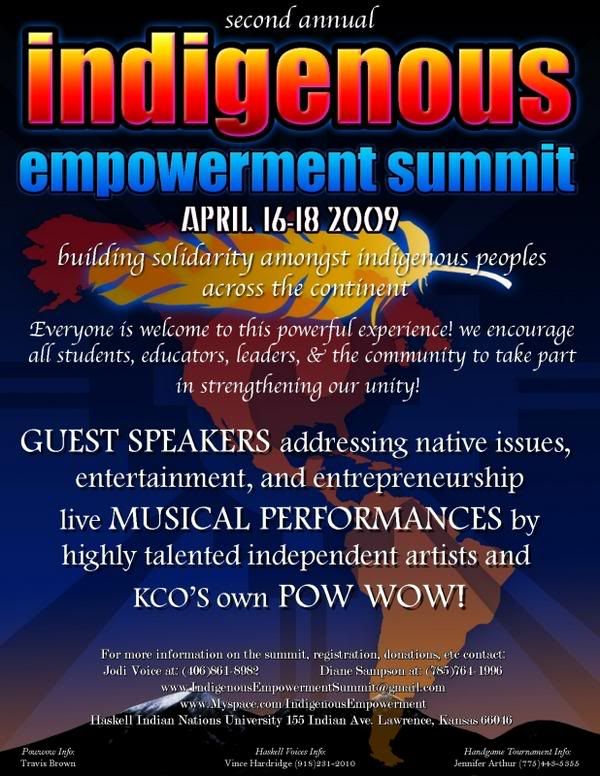
http://www.onetruemedia.com/shared?p=86742e941a3bb4f3bee4ef&skin_id=701&large&utm_source=otm&utm_medium=embed
Host: Indigenous Youth in all walks of life
Type: Meetings - Convention
Network: Global
Start Time: Thursday, April 16, 2009 at 8:00am
End Time: Saturday, April 18, 2009 at 11:00pm
Location: Haskell Indian Nations University Campus
Street: Indian Ave
City/Town: Lawrence, KS

Promoting awareness of sovereignty,ecological, social, cultural and new issues impacting Indigenous people.
Creating leadership, and mentorship, and fostering opportunities for our future leaders.
Guests are leaders from all areas of academia, activism, business, entertainment and media. We seek to bring communities of Indigenous people together.
Using Unity to provide a platform for an open dialogue toward the progressive needs of our people.
Strengthen the unity, networks and relationships through this community building endeavor.
Empower the youth to look to the ancestors and elders/leaders, enhancing the future, creating mentors and relationships to strengthen the indigenous network for generations to come.

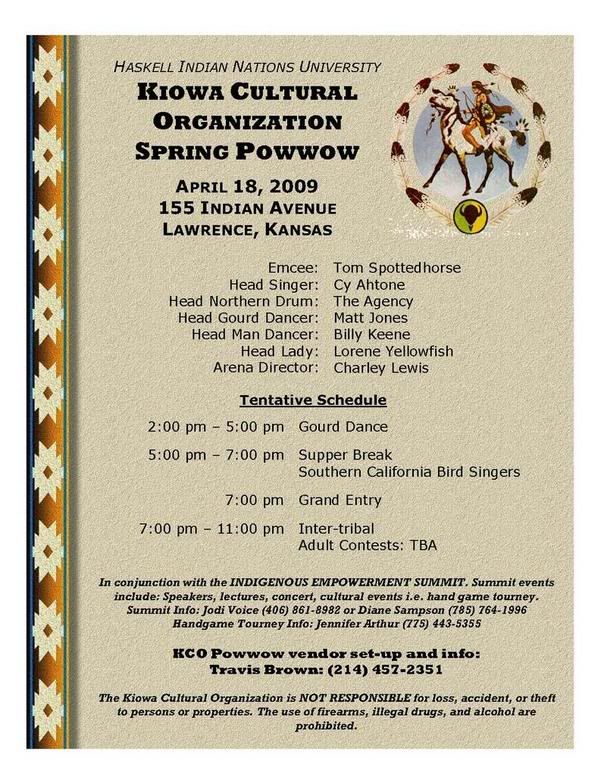
Come one, come all, to our presentations, concerts, films, feasts and powwow!
Indigenous Empowerment Summit, is now a 501(c)3!
So what does this mean? It “provides a deduction, for federal income tax purposes, for some donors who make charitable contributions to most types of 501(c)(3) organizations”.
For More Up To Date Information Contact:
Jodi Voice
IndigenousEmpowermentSummit@gmail.com
www.IndigenousEmpowermentSummit.org
www.myspace.com/IndigenousEmpowerment
(406) 861-8982
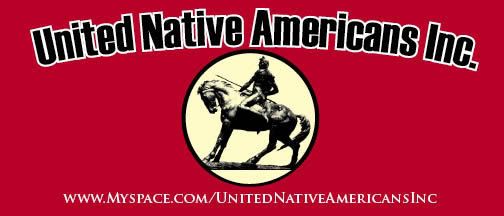

http://www.onetruemedia.com/shared?p=86742e941a3bb4f3bee4ef&skin_id=701&large&utm_source=otm&utm_medium=embed
Host: Indigenous Youth in all walks of life
Type: Meetings - Convention
Network: Global
Start Time: Thursday, April 16, 2009 at 8:00am
End Time: Saturday, April 18, 2009 at 11:00pm
Location: Haskell Indian Nations University Campus
Street: Indian Ave
City/Town: Lawrence, KS

Promoting awareness of sovereignty,ecological, social, cultural and new issues impacting Indigenous people.
Creating leadership, and mentorship, and fostering opportunities for our future leaders.
Guests are leaders from all areas of academia, activism, business, entertainment and media. We seek to bring communities of Indigenous people together.
Using Unity to provide a platform for an open dialogue toward the progressive needs of our people.
Strengthen the unity, networks and relationships through this community building endeavor.
Empower the youth to look to the ancestors and elders/leaders, enhancing the future, creating mentors and relationships to strengthen the indigenous network for generations to come.


Come one, come all, to our presentations, concerts, films, feasts and powwow!
Indigenous Empowerment Summit, is now a 501(c)3!
So what does this mean? It “provides a deduction, for federal income tax purposes, for some donors who make charitable contributions to most types of 501(c)(3) organizations”.
For More Up To Date Information Contact:
Jodi Voice
IndigenousEmpowermentSummit@gmail.com
www.IndigenousEmpowermentSummit.org
www.myspace.com/IndigenousEmpowerment
(406) 861-8982

Subscribe to:
Posts (Atom)

